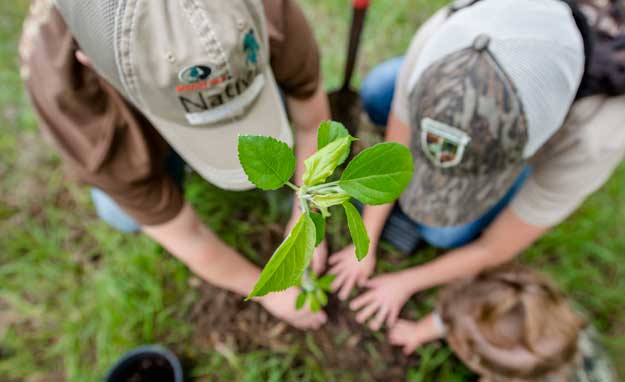
So you’re considering planting a few tree seedlings this season, or already have some in the ground, but want them to have the best chance at fast growth and early and abundant production of fruits and nuts? Aside from protecting your seedlings with tree tubes (also known as tree protectors) and applying fertilizer, you’ll need to provide some form of weed control and/or mulch. Here are your best options:
Organic Mulch
Pine straw, wood chips, bark, hay, and compost are examples of organic mulches that can be placed around a young tree to smother weeds and help trap moisture that would otherwise evaporate from the soil surface. The best part about organic mulch is that it breaks down over time and improves your soil, which is great for your trees. You can buy organic mulch as bark, wood chips, hay, or straw- or you can gather your own for free.
Weed mats
Weed mats are generally porous woven fabric or non-porous plastic, and are designed to block the growth of weeds and retain moisture trying to escape from the soil. They are commonly available in pre-cut 2’ and 3’ square sizes. Although both forms work well to smother weeds, plastic mulch is better than the porous fabric at trapping moisture and directing it to the roots. If you live in an area that is prone to droughts in the summer, plastic mulch is the way to go. Once the tree is established after a couple of years, it’s best to remove the weed mats and consider mulching with organic mulch.
Herbicide
Maintaining a 2’-3’ weed free radius around each seedling is the key to having high survival rates and excellent 1st and 2nd year growth. Non-selective herbicides such as glyphosate (the active ingredient in roundup herbicide) control weeds that rob your seedlings of moisture and nutrients. Keep in mind that herbicides can damage or kill your trees if used improperly, so always read and follow the label. One treatment (of glyphosate) in May and another in July or August is sufficient to keep the area weed free during the growing season.
Mechanical control
There are several methods of mechanical control that can employ different tools for the job, but they all involve physically removing the weeds from around your trees. Hoes or shovels can be used to chop weeds, and if you don’t mind getting dirty, hand pulling weeds can be effective.
Combinations
All methods mentioned above are far better than allowing your seedlings to fend for themselves. However, several combinations of these techniques work even better. For example, using herbicide or mechanical control to keep a 1’ radius around either plastic or organic mulch will keep weeds from getting the moisture your mulch has conserved. Another combination, common with apple growers is to place rocks or pebbles on top of plastic mulch.
Whichever method you choose, keeping unwanted weeds and grasses away from your crop trees will reward you with greatly increased first and second year survival, and exponentially faster growth rates. Better growth and survival leads to more mast crops and production at an earlier age. Weed control and/or mulch is a no-brainer. Use it!
This tip is courtesy of the GameKeepers Field Notes, a weekly wildlife and land management email newsletter produced by the Mossy Oak GameKeepers.
A GameKeeper by definition is someone who truly loves AND lives the land, the critters and nature…not just during hunting season but all the time. A GameKeeper wants to be outdoors every day and work the dirt while living their personal “obsession”.
Find out more about what makes a GameKeeper by visiting our website.




























